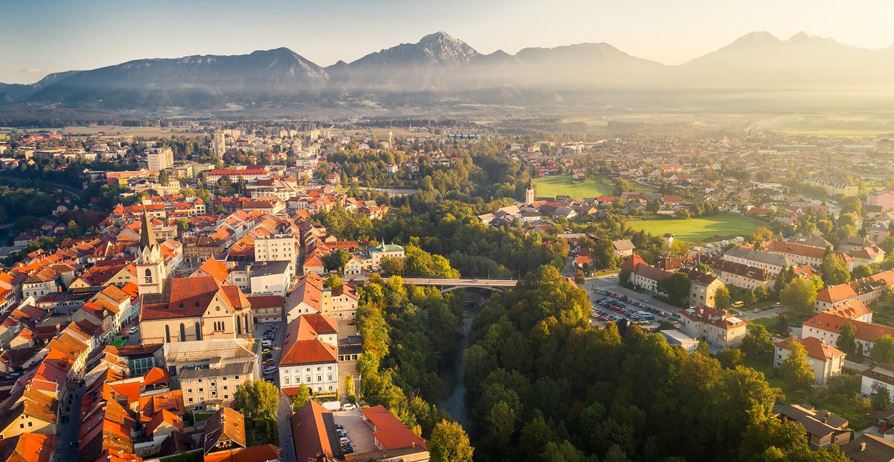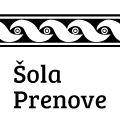Through Prešeren's town
If you follow in the poet's footsteps, you meet painters, architects, and photographers. You move from Prešeren's 19th century into prehistory, the Middle Ages and back to modernity. Descend into the Kokra canyon and into the mysterious underground world beneath the old town of Kranj.
In the heart of Prešeren's town
Start your wanderings around Kranj, the town of France Prešeren, the greatest Slovenian poet, on Glavni trg square. Stop at Pavšlar House, which houses an eminent Gallery of Prešeren Award Laureates (1). You can also see interesting permanent exhibitions in the Renaissance Town Hall (2) just opposite the gallery. Follow the path to St. Kancijan’s Church (3) with a mighty, 60-meter-high bell tower, which will open to visitors in summer 2021. The Ossuary next to the church is part of the largest old Slavic burial ground in Slovenia. Standing opposite the church, in front of the Prešeren Theatre (4), is the statue of France Prešeren, which at five meters high is considered the largest monument to the poet in the world.
A Tip: On Glavni trg square you can treat yourself to a traditional Slovenian lunch at the Mayer Inn, and stop at the Café and Confectionery, surrounded by the masterpieces of a local florist Matjaž Beguš, for modern desserts.
To Pungert the oldest part of Kranj
From Glavni trg, continue along Cankarjeva ulica street. On the right side of the street, a monumental entrance to the town awaits you, as imagined by the famous architect Jože Plečnik. See Plečnik’s stairs, a fountain and arches (5). Continue to Trubarjev trg square and to the end of the rocky promontory on which Kranj stands. This is Pungert (6), a part of the town centre with traces of the past dating back at least six thousand years! Step onto the viewing platform at the end of the cliff that rises high above the Kokra River. From there you can also see the confluence of the rivers Sava and Kokra, Šmarjetna gora and Sv. Jošt, the local hills. The latter, with Dom na Joštu hut, offers excellent cuisine and is also famous for the largest Slovenian book exchange site.
A Tip: There are children’s playgrounds and a pleasant café (Kavarna in galerija Pungert) on Trubarjevo. On warm days when the windows are open, you can listen to melodies from the Kranj Music School.
Among valuables in Khiselstein
When returning from Pungert, turn left at Plečnik’s stairs. Here you will see Khislstein Castle (7) with a lookout castle garden, a café and Summer Stage. The castle is home to the Gorenjska Museum (8), which, among other things, houses an exceptional late antique find. Two lamellar armours, worn only by the most prominent Byzantine and Germanic soldiers in Europe in the 6th century, are unique on the Old Continent.
To the tower and artists's houses
Not far from the castle is the Škrlovec Tower (9), an additional fortress of the town’s walls during the Turkish raids. The ground floor has space for smaller performances, concerts, and cultural evenings; the upper floor is a gallery. Near the tower is the bourgeois Layer House (10), in which the painter Leopold Layer lived at the turn from the 18th to the 19th century. Today, however, the house is the centre of the cultural district. It hosts various cultural events throughout the year. Opposite the house, which has always been associated with art, is the office of Janez Puhar (11), the inventor of glass photography. Enter his 19th-century studio and choose from interactive adventure games.
A visit to Prešeren
Turn right onto Glavni trg square and then left onto Prešernova ulica street, where you can relive the 19th century in the poet’s way in Prešeren’s House (12). Visit the memorial Museum with a permanent exhibition about his life and work. After the visit, continue to Maistrov trg square and turn right to the Kranj Town Library (13), where his verses are written in the poet’s characteristic handwriting. Continue along Partizanska ulica street and you will reach the poet’s last resting place – the Prešeren Grove Memorial Park. (14).
A Tip: On the way to the library, you can look at the poet’s town from the roof of the former Old Post Office Hotel in a new way. Take the elevator or the winding stairs to the panoramic terrace of the Panorama Stara pošta café. On Maistrov trg square, there is also the Kot Inn, which offers popular Carniolan štruklji (rolled dumplings) and Kavka bar is the go-to-place if you enjoy good music.
To the canyon and tunnels under the old town of Kranj
Round up your wander around the town with a walk through the canyon of the Kokra River or with a guided tour of the tunnels beneath old Kranj. The town with a 30 meter deep river canyon in the very centre of the town is a peculiarity on a global scale. You can reach the starting point for the circular path through the Kokra canyon (15) opposite the Town Library, down the Kokrški breg bank or on the other side of the town in Poštna ulica street, where steps lead you down to the canyon. A special feature of the town are also the tunnels under the old town (16), which served as a town shelter in the Second World War. The guided tour, in addition to other contents and exhibitions, also includes the reconstruction of the shelter with an air attack simulation. You can arrange a tour at the Tourist Information Centre in Kranjska hiša (17).
Suggestion for a hike
Brdo estate
You can reach the Brdo protocol estate in Predoslje, which is 5 kilometres away, by renting a bicycle or by car. The estate with white Lipizzaner horses, painted beehive panels and straw-covered hayracks presents Slovenia in a nutshell. On almost 500 hectares of the park, tree-lined avenues, ponds and forests surprise the visitor. A part of the estate is the Renaissance castle Brdo, today a protocol building of the Republic of Slovenia. Admission to the park is free for all who spend the night in Kranj in 2021. In Predoslje, it is well worth to pay a visit to the Krištof inn (Predoslje 22), which boasts two Michellin awards – Michelin Sustainability Award and the Plate Michelin.
Opposite the inn, you can stop in the courtyard of the Odems Farm (Predoslje 41), where it smells of hay. The yard of the farm turns into a small market place every day, where you can get many dairy products from hay milk.
More information: Kranj TIC
www.visit kranj.com
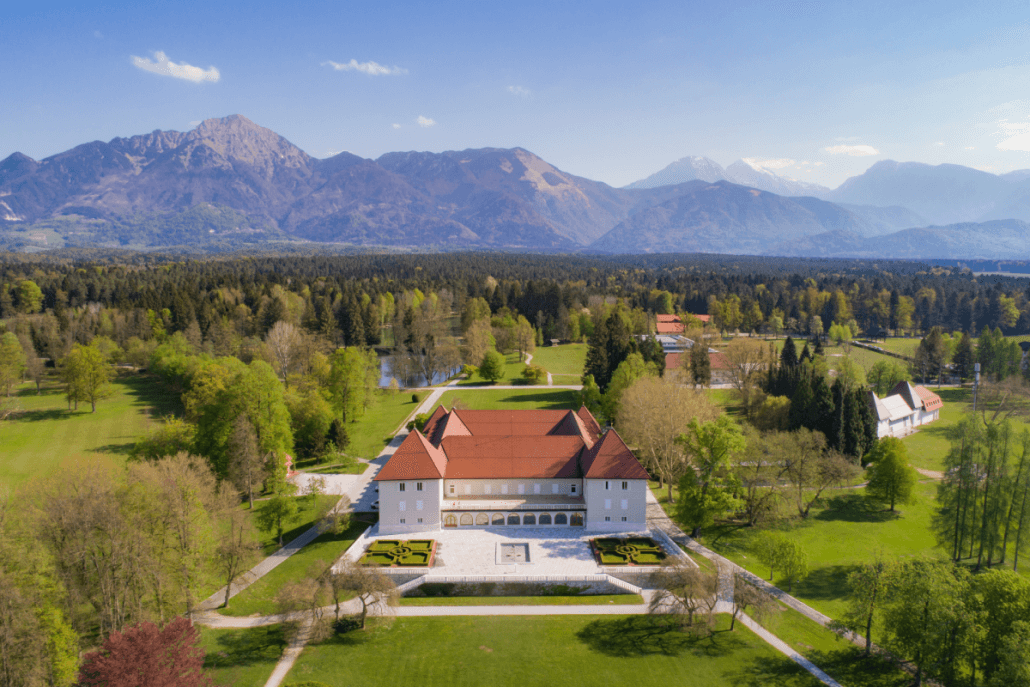
1. Gallery of Prešeren award Laureates
In Pavšlar House, a rich bourgeois building from the 16th century, which has preserved Gothic portals and acquired beautiful arcaded corridors over time, the Gallery of Prešeren Award Laureates exhibits works by the recipients of the most prestigious awards for fine arts in Slovenia. There are already more than 140 works in the permanent collection, and new winners supplement the collection every year with their works.
Pavšlar house, Glavni trg 18, T: 04 202 57 16
2. Town Hall
The house, which is among the most important cultural monuments of Renaissance architecture in Slovenian, displays works by the sculptor Lojze Dolinar and an ethnological exhibition of Folk Art in the Gorenjska Region. Additionally, there is the Iron Thread archaeological exhibition, which presents findings from prehistoric times to the time when Karnij became Kranj. The heart of the exhibition are finds from Old Slavic graves, including luxurious equipment that proves the existence of tribal aristocracy.
Glavni trg 4, T: 04 201 39 80
3. St. Kancijan's church
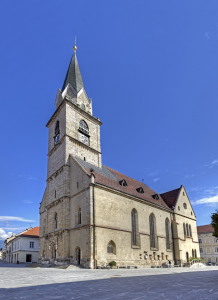
The church in the centre of Kranj is the most important monument of Gothic architecture in Slovenia. It stands on the site of an older church from the 6th century, which makes Kranj one of the oldest church centres on Slovenian soil. The mighty bell tower will also be open to visitors from 2021 on, and you will be able to buy a ticket at the TIC. The steep staircase will take you to the lookout s platform 40 meters above the ground. In the ossuary next to the church, in the covered underground space, the masonry foundations of the late antique baptistery, the lower remains of the 13th century ossuary wall and the remains of the cemetery chapel with a tomb from the 15th century are visible.
Glavni trg
4. Prešeren theatre
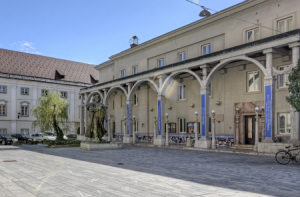
The building of the Prešeren Theatre, which has been redesigned several times, was enriched by the famous architect Jože Plečnik after the Second World War. He added arcades and his characteristic lights. He also helped with the installation of the monument to France Prešeren in the space. The five- meter-high bronze casting is the work of sculptors Frančišek Smerdu and Peter Loboda. The monument was unveiled in 1952. Every year, the theatre organizes Slovenian Drama Week, this year for the 51st time in a row.
Glavni trg 6, T: 04 280 49 00
5. Plečnik stairs
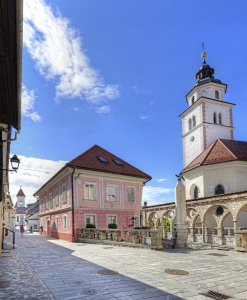
On the staircase, designed as a monumental entrance to the town by the internationally renowned Jože Plečnik, there is a fountain with a bronze rooster, from which water flows into stone terraced basins. Above the stairs, next to St. Mary of the Rosary Church, are Plečnik’s arcades, which complement the grandeur of the staircase.
Cankarjeva ulica 14
6. Pungert
There were prehistoric dwellings on Pungert, which are now symbolically marked by a metal floor covering on the pavers. Here is the only fully preserved medieval defensive tower from the 16th century that served as a town dungeon. Next to the tower, the Gothic branch church of St. Sebastian, Fabian and Roch – protectors against deadly disease was built during the plague in the 15th century. Where the rock above the Kokra River meets the town walls and where the viewing platform is today, there used to be the southernmost defensive tower. Today, Pungert is a popular gathering spot for the people of Kranj. In summer, there are music events and the famous Jazz Kamp. The youngest are attracted by the outdoor play equipment and the Pungert Children’s Tower.
Trubarjev trg
7. Khislstein Castle
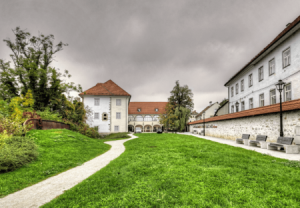
The castle, the beginnings of which date back to the 13th century, is named after the Khisl family, who bought it in the second half of the 16th century. Famous royal families, such as the Ortenburgs, the Counts of Cilli, the Habsburgs, the Auerspergs and many others, passed ownership from hand to hand. The castle changed its appearance and function through time. Today it houses the Gorenjska Museum and is the venue of the annual Khislstein Summer Stage, where a varied cultural program takes place. Summer film evenings take place in the Vovk garden and concerts sound under the castle linden tree.
Gorenjska museum, Tomšičeva 44
8. Gorenjska museum
The central Gorenjska Gallery and Museum take care of the archaeological and ethnological collection, the collections of art, cultural and recent history and modernity. In the Khislstein castle, the permanent Beautiful Gorenjska exhibition is on display, designed as a walk through time in twelve episodes. More than 1,300 museum objects are on display, and the contents of individual rooms are summarized in selected verses from Prešeren’s poetry and folk songs. The story of Beautiful Gorenjska is enlivened by sound spaces, numerous photographs, documentaries and feature films.
Tomšičeva 44, T: 04 201 39 50
9. Škrlovec tower
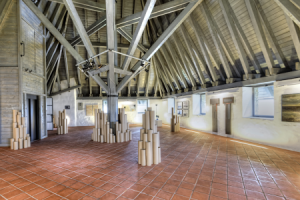
During the Turkish raids, the tower served as armory and was considered as one of the major parts of the town walls. After the renovation in 2011, it became a venue for various cultural events, especially for innovative approaches. The gallery in the tower hosts photographers, multimedia and intermedia artists.
Tomšičeva 32, T: 31 279 331
10. Layer house
The multi-storey burgher house is home to a café with a bookstore, souvenir corner, space for artistic creation, the Layer House Gallery, and the Mahlerca multi-purpose space. Forma viva is exhibited in the garden. Leopold Layer (1752–1828), a late Baroque painter whose paintings adorned almost every house in Kranj in the middle of the 19th century, inhabited the house. His most famous work is the gracious image of Mary Help of Christians.
Tomšičeva 32
11. Janez Puhar studio
Get to know the world of Janez Puhar (1814 – 1894), the first Slovene photographer, the inventor of photography on glass and the author of the first real photographic selfie. The museum room shows Puhar’s life and the process of photographing on glass. In the 19th-century studio, you can order a photographic portrait in period clothes. Follow Puhar’s secret by discovering colour photography through puzzles and codes with the adventure game Puhar’s Secret Lab. The Hunting for a Lost Photo game takes you to hidden corners of the town in an interactive way.
Tomšičeva 13, T: 031 37 92 37
12. Prešeren House
Kranj is the town of France Prešeren (1800 – 1849), the greatest Slovenian poet, who marked Slovenia with the pan-European spirit of romance. He wrote sonnets and romances. A part of his poem Zdravljica is the anthem of the Republic of Slovenia. In the house where he spent the last years of his life is his office with authentic furniture. The exhibition includes the printing manuscript of his Poezije collection, originals and facsimiles of his poems as well as objects from his personal archives.
Prešernova 7, T: 051 615 388
13. Kranj City Library
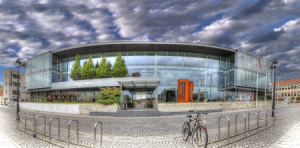
The Globus building, a former department store, designed by architect Edvard Ravnikar, the winner of Prešeren Prize for lifetime achievement, became one of the most beautiful Slovenian libraries after reconstruction in 2011. Its rich collection of books, films and music, as well as cultural and educational events, make it the living room of the town. Verses by France Prešeren are written in his characteristic handwriting on glass on the façade.
Gregorčičeva ulica 1, T: 04 201 35 55
14. Prešeren grove
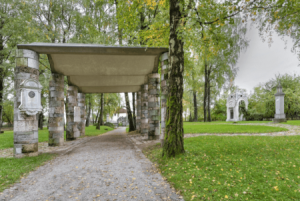
The tombstone and the bust of the poet France Prešeren are in the memorial park in the centre of the town. The park with trees is located on the site where there was a town cemetery from 1798 until the time before the Second World War. There is the gravestone of the poet Simon Jenko, the tombstone of the inventor Janez Puhar, the Majdič family tomb with a marble relief Ascension, and a monument to the victims of Bazovica, the first monument to the victims of fascist violence in Europe.
Between Gregorčičeva and Partizanska ulica
15. The Kokra river canyon circular route
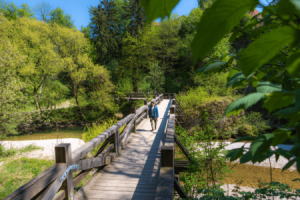
A circular path leads through the second highest urban canyon in Europe, presenting a diverse mosaic of aquatic and riparian biotopes. The river, the banks, gravel pits, meadows with floodplain forest, boulders, and conglomerates are home to a variety of animal species, trees, shrubs and herbs. The path takes you through a tall orchard with old tree varieties and past the remains of a mill in a carved rock wall. In TIC, you can also arrange for a guided tour of the canyon.
16. Tunnels under the old town of Kranj
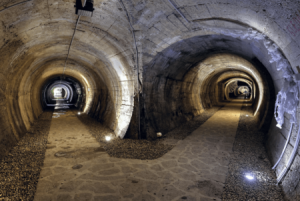
In the 1,300-meter-long tunnels beneath Kranj, which are the work of human hands, the conditions are similar to those in natural caves. Stalactites form here as well. Rare cave animals such as cave crickets, spiders and cave spiders dwell in the tunnels. The two exhibitions show the origin of the tunnels and display minerals and fossils. In addition to regular guided tours, there are occasional special events held here. Since 2008, every November, Slovenian wine makers have been presenting themselves.
17. 17. Tourist Information Centre
At the Tourist Information Centre, which operates in an old townhouse called Kranjska hiša you can book guided urban, active or adventure trips and choose souvenirs. Here you will find all the information about the town and inspirations for trips, vacations, holidays.
Kranjska hiša, Glavni trg 2
- 11. Gallery of Prešeren award Laureates
- 22. Town Hall
- 33. St. Kancijan's church
- 44. Prešeren theatre
- 55. Plečnik stairs
- 66. Pungert
- 77. Khislstein Castle
- 88. Gorenjska museum
- 99. Škrlovec tower
- 1010. Layer house
- 1111. Janez Puhar studio
- 1212. Prešeren House
- 1313. Kranj City Library
- 1414. Prešeren grove
- 1515. The Kokra river canyon circular route
- 1616. Tunnels under the old town of Kranj
- 1717. 17. Tourist Information Centre


